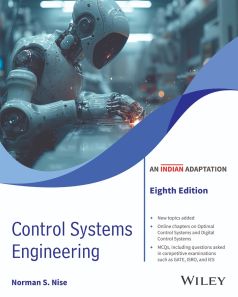Control Systems Engineering, 8ed (An Indian Adaptation)
ISBN: 9789357463980
844 pages
For more information write to us at: acadmktg@wiley.com

Description
This Indian adaptation of the text maintains those aspects of the previous editions that have led to the book being so successful. In addition to introducing a new chapter on Optimal Control Systems, this edition strengthens the coverage by including new sections on Servomechanism, Multivariable Systems, Tuning of PID Controller, and All-Pass and Non-Minimum Phase Systems. Many of the end-of-chapter problems have been revised and new problems have been added. It also includes multiple choice questions based on the questions from various competitive examinations.
1. INTRODUCTION
1.1 Introduction
1.2 System Configurations
1.3 Servomechanism
1.4 A History of Control Systems
1.5 Analysis and Design Objectives
1.6 The Design Process
1.7 Multivariable Systems
1.8 Computer-Aided Design
1.9 The Control Systems Engineer
Summary
Multiple Choice Questions
Review Questions
Problems
Cyber Exploration Laboratory
Bibliography
2. MODELING IN THE FREQUENCY DOMAIN
2.1 Introduction
2.2 Laplace Transform Review
2.3 The Transfer Function
2.4 Electrical Network Transfer Functions
2.5 Translational Mechanical System Transfer Functions
2.6 Rotational Mechanical System Transfer Functions
2.7 Transfer Functions for Systems with Gears
2.8 Electromechanical System Transfer Functions
2.9 Electric Circuit Analogs
2.10 Nonlinearities
2.11 Linearization
Summary
Multiple Choice Questions
Review Questions
Problems
Cyber Exploration Laboratory
Hardware Interface Laboratory
Bibliography
3. MODELING IN THE TIME DOMAIN
3.1 Introduction
3.2 Some Observations
3.3 The General State-Space Representation
3.4 Applying the State-Space Representation
3.5 Converting a Transfer Function to State Space
3.6 Converting from State Space to a Transfer Function
3.7 Linearization
Summary
Multiple Choice Questions
Review Questions
Problems
Cyber Exploration Laboratory
Bibliography
4. TIME RESPONSE ANALYSIS
4.1 Introduction
4.2 Poles, Zeros, and System Response
4.3 First-Order Systems
4.4 Second-Order Systems: Introduction
4.5 The General Second-Order System
4.6 Underdamped Second-Order Systems
4.7 System Response with Additional Poles
4.8 System Response with Zeros
4.9 Effects of Nonlinearities upon Time Response
4.10 Laplace Transform Solution of State Equations
4.11 Time Domain Solution of State Equations
Summary
Multiple Choice Questions
Review Questions
Problems,
Cyber Exploration Laboratory
Hardware Interface Laboratory
Bibliography
5. REDUCTION OF MULTIPLE SUBSYSTEMS
5.1 Introduction
5.2 Block Diagrams
5.3 Analysis and Design of Feedback Systems
5.4 Signal-Flow Graphs
5.5 Mason’s Rule
5.6 Signal-Flow Graphs of State Equations
5.7 Alternative Representations in State Space
5.8 Similarity Transformations
Summary
Multiple Choice Questions
Review Questions
Problems
Cyber Exploration Laboratory
Bibliography
6. STABILITY
6.1 Introduction
6.2 Routh–Hurwitz Criterion
6.3 Routh–Hurwitz Criterion: Special Cases
6.4 Routh–Hurwitz Criterion: Additional Examples
6.5 Stability in State Space
Summary
Multiple Choice Questions
Review Questions
Problems
Cyber Exploration Laboratory
Bibliography
7. STEADY-STATE ERRORS
7.1 Introduction
7.2 Steady-State Error for Unity-Feedback Systems
7.3 Static Error Constants and System Type
7.4 Steady-State Error Specifications
7.5 Steady-State Error for Disturbances
7.6 Steady-State Error for Nonunity-Feedback Systems
7.7 Sensitivity
7.8 Steady-State Error for Systems in State Space
Summary
Multiple Choice Questions
Review Questions
Problems
Cyber Exploration Laboratory
Bibliography
8. ROOT LOCUS TECHNIQUES
8.1 Introduction
8.2 Defining the Root Locus
8.3 Properties of the Root Locus
8.4 Sketching the Root Locus
8.5 Refining the Sketch
8.6 An Example
8.7 Transient Response Design via Gain Adjustment
8.8 Generalized Root Locus
8.9 Root Locus for Positive-Feedback Systems
8.10 Pole Sensitivity
Summary
Multiple Choice Questions
Review Questions
Problems
Cyber Exploration Laboratory
Hardware Interface Laboratory
Bibliography
9. DESIGN VIA ROOT LOCUS
9.1 Introduction
9.2 Improving Steady-State Error via Cascade Compensation
9.3 Improving Transient Response via Cascade Compensation
9.4 Improving Steady-State Error and Transient Response
9.5 Feedback Compensation
9.6 Physical Realization of Compensation
9.7 Tuning of PID Controllers
Summary
Multiple Choice Questions
Review Questions
Problems
Cyber Exploration Laboratory
Hardware Interface Laboratory
Bibliography
10. FREQUENCY RESPONSE TECHNIQUES
10.1 Introduction
10.2 Asymptotic Approximations: Bode Plots
10.3 All-Pass and Non-Minimum Phase Systems
10.4 Introduction to the Nyquist Criterion
10.5 Sketching the Nyquist Diagram
10.6 Stability via the Nyquist Diagram
10.7 Gain Margin and Phase Margin via the Nyquist Diagram
10.8 Stability, Gain Margin, and Phase Margin via Bode Plots
10.9 Relation Between Closed-Loop Transient and Closed-Loop Frequency Responses
10.10 Relation Between Closed- and Open-Loop Frequency Responses
10.11 Relation Between Closed-Loop Transient and Open-Loop Frequency Responses
10.12 Steady-State Error Characteristics from Frequency Response
10.13 Systems with Time Delay
10.14 Obtaining Transfer Functions Experimentally
Summary
Multiple Choice Questions
Review Questions
Problems
Cyber Exploration Laboratory
Bibliography
11. DESIGN VIA FREQUENCY RESPONSE
11.1 Introduction
11.2 Transient Response via Gain Adjustment
11.3 Lag Compensation
11.4 Lead Compensation
11.5 Lag–Lead Compensation
Summary
Multiple Choice Questions
Review Questions
Problems
Cyber Exploration Laboratory
Bibliography
12. DESIGN VIA STATE SPACE
12.1 Introduction
12.2 Controller Design
12.3 Controllability
12.4 Alternative Approaches to Controller Design
12.5 Observer Design
12.6 Observability
12.7 Alternative Approaches to Observer Design
12.8 Steady-State Error Design via Integral Control
Summary
Multiple Choice Questions
Review Questions
Problems
Cyber Exploration Laboratory
Bibliography
13. OPTIMAL CONTROL SYSTEMS (Available Online)
13.1 Introduction
13.2 Performance Indices
13.3 Optimal Control Problem
13.4 Regulator Problem
13.5 State Regulator
13.6 Output Regulator
13.7 Tracking Problem
Summary
Multiple Choice Questions
Review Questions
Problems
Cyber Exploration Laboratory
Bibliography
14. DIGITAL CONTROL SYSTEMS (Available Online)
14.1 Introduction
14.2 Modeling the Digital Computer
14.3 The z-Transform
14.4 Transfer Functions
14.5 Block Diagram Reduction
14.6 Stability
14.7 Steady-State Errors
14.8 Transient Response on the z-Plane
14.9 Gain Design on the z-Plane
14.10 Cascade Compensation via the s-Plane
14.11 Implementing the Digital Compensator
Summary
Multiple Choice Questions
Review Questions
Problems
Cyber Exploration Laboratory
Bibliography
APPENDIX A1 List of Symbols
APPENDIX A2 Antenna Azimuth Position Control System
APPENDIX A3 Unmanned Free-Swimming Submersible Vehicle
APPENDIX A4 Key Equations
GLOSSARY
ONLINE APPENDICES
APPENDIX B MATLAB Tutorial
APPENDIX C Simulink Tutorial
APPENDIX D LabVIEW Tutorial
APPENDIX E MATLAB’s GUI Tools Tutorial
APPENDIX F MATLAB’s Symbolic Math Toolbox Tutorial
APPENDIX G Matrices, Determinants, and Systems of Equations
APPENDIX H Control System Computational Aids
APPENDIX I Derivation of a Schematic for a DC Motor
APPENDIX J Derivation of the Time Domain Solution of State Equations
APPENDIX K Solution of State Equations for t0 ≠ 0
APPENDIX L Derivation of Similarity Transformations
APPENDIX M Root Locus Rules: Derivations
ANSWERS TO SELECTED PROBLEMS
INDEX

